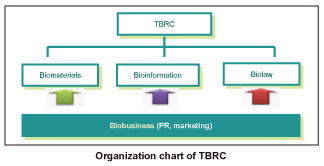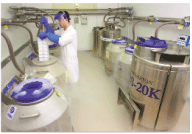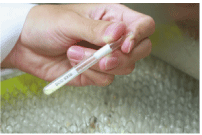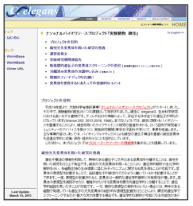|
 |
■ Bioresources information is available at the following URLs
|
 |
|
Thailand Bioresource Research Center (TBRC):
Management of Thailand Biodiversity
Dr. Lily Eurwilaichitr, Deputy Executive Director of BIOTEC
With an expansion of bio-based industry in Thailand and this region, the National Center for Genetic Engineering and Biotechnology (BIOTEC) took a lead in establishing Thailand Bioresource Research Center (TBRC). The initiative is also timely due to recent adoption of Nagoya Protocol (NP) which is the latest international instrument that addresses rules and procedures on access and benefit sharing (ABS) of genetic resources under the Convention on Biological Diversity (the CBD). |
TBRC aims to hold selected high quality biological materials with known characteristics for services to clients with an international quality standard "OECD best practice guidelines for biological resource center". For microorganisms, strains provided will be from culture collection network from all over Thailand, ensuring the high diversity of microorganisms. To facilitate the maximum utilization of our microbial strains, bioinformatics and biotechnological tools will be utilized to provide useful information, e.g. gene sequence, enzyme screening results, and chemical compounds database.
To serve country's need for management of bioresources, TBRC also provides a management tool to support conservation and utilization of bioresources in Thailand and ASEAN countries. The database management system developed by BIOTEC, iCollect, will be employed in the TBRC network to facilitate the linkage of bioresource database. This will allow each collection to gain more visibility to the user communities as well as to provide efficient traceability that complied with NP for access and benefit sharing. One of our main activities is to educate culture collections in Thailand to be well-aware of this legal issue and to develop guidelines to be used in Thailand and ASEAN.
|
TBRC will be inaugurated in March 2014 at a new state-of-the-art complex located in Thailand Science Park, home to Thailand’s premiere S&T organizations and research centers (biotechnology, computer technology, material science and nanotechnology), as well as leading local and multinational hi-tech companies such as Betagro, Ecolab, Mitr Phol, PTT Phenol, Polyplastics, SCG, Western Digital, Air Products and Zoetis (formerly known as Pfizer Animal Health). |
 |
TBRC is divided into four main groups including Biological materials, Bioinformation and Biolaw which are supported by Biobusiness.
Biological materials group aims to offer a selected range of special services to private and public sectors in culture collection preservation and identification as well as technical training. TBRC will also curate other biomaterials, e.g. plasmid DNA, animal cell lines, hybridoma clones and plant germplasms.
Bioinformation group aims to establish the information infrastructure to provide integrated access to information of Thailand’s biological resources, and develop computational techniques including bioinformatics in order to accelerate the value creation from bioresouces. TBRC links diverse biological resource databases and analytical tools maintained by TBRC partners and collaborators. In addition, TBRC develops the standardization for processing the information incurred in the material transfer and benefit sharing.
Biolaw aims to develop documents for overall operation of TBRC activities (e.g. Material Transfer Agreement (MTA), Material Acquisition Agreement (MAA), and licensing agreement) and provide legal management of bioresource. Moreover, TBRC biolaw will provide a consultation in biolaw services to other culture collections.
Biobusinessaims to coordinate with the relevant business units, study and develop crucial bioresource databases for making product portfolio, study and analyze industries related to biological resources to develop an appropriate action plan for biological resource center.
|
 |
TBRC extensive network includes:
- Thailand Network on Culture Collections (TNCC), comprising four major culture collections in Thailand at BIOTEC, the Department of Medical Sciences, the Department of Agriculture and Thailand Institute of Scientific and Technological Research.
- Network of bioresource research centers of universities in Thailand
- Network on bioresource research centers in ASEAN. ASEAN Network on Microbial Utilization will be formed in February 2014, with memberships from academic and research institutes in ASEAN
|
Status of Biological Materials at BIOTEC |
BIOTEC has, during the past decade, conducted and invested in research programs toward the sustainable utilization of biological resources, which include management of microbial resources and conducting research program on microbial utilization. By implementing guidelines compiled by the OECD, BIOTEC has established BIOTEC Culture Collection (BCC) since 1996, to be a national depositary and distribution for microbes. Approximately 63,854 strains (1,038 genera, 2,027 species) have been collected and preserved at the BCC; these included 41,099 fungi (809 genera, 1,264 species), 6,514 yeasts (63 genera, 315 species) and 15,971 bacteria (166 genera, 448 species) as of September 2013. These strains are maintained by freezing and/or freeze drying to ensure their genetic stability for long term storage. Many precautionary steps have been taken to ensure the survival and integrity of the preserved cultures; these preventative measures have included automated temperature control and regulator units, temperature monitoring with alert systems, and back-up power-storage units. BCC has also been certified with ISO 9001:2000 as a service provider since 2005. The facility is also designated by the Department of Intellectual Property as a repository of patent-related microorganisms.
Majority of microbes in BCC are used for research targeted to human health, environmental improvement, as well as agricultural and industrial applications. At present, the collection maintains more than 6,000 isolates with potential use in drug discovery, and more than 2,000 isolates show enzyme activities for agricultural and industrial applications. Furthermore, almost 400 strains are type species used in defining the taxon.
Apart from extensive work on microbial collection, BIOTEC also collected and preserved other biomaterials for both research and industrial utilization. BIOTEC also collected and preserved other biological materials for both research and industrial utilization. These include 42 vectors, 21 hosts, and 80 recombinant clones and 430 hybridoma clones (for antibody production). BIOTEC Bangkok Herbarium (BBH) preserves 34,681 dried specimens of fungi. |
 |
 |
Once TBRC has officially opened in 2014, BCC's microbial collection and other biomaterial collections at BIOTEC will be gradually transferred to TBRC for more complete management of bioresource of BIOTEC and its network in Thailand and ASEAN.
To learn more about TBRC, please visit www.biotec.or.th/tbrc. |
"This article is written in English by author." |
|
|
National BioResource Project "C. elegance"
|

• Mutants: 5,482 strains
• Promoters/markers:187 plasmids
(As of December 2013) |
|
| DB name: |
C. elegans |
| URL: |
http://www.shigen.nig.ac.jp/c.elegans/ |
| Language: |
Japanese, English
|
| Contents: |
▪ |
Alleles, phenotypes, mutation sites, gene structures, and primer sequences of C. elegans mutants. |
| ▪ |
Construct names, gene names, and expression patterns of the promoters/markers. |
| Features: |
▪ |
Through its website, the DB accepts information from users on mutant screening of new target genes, and the users can observe the progress status of the screening.
|
| ▪ |
The DB discloses information on the distribution destinations of its resources. |
| ▪ |
The DB also contains many feedback comments on papers. |
| Cooperative DB :
Worm Base, RRC (DB for research papers) |
| DB construction group : NBRP C. elegans, NBRP Information |
| Management organization : Genetic Resource Center, NIG |
| Year of first DB publication : 2003 Year of last DB update : 2013 |
|
Comment from a practicing developer: The NBRP C. elegans database is unique because it has been stably managed and it has had no major changes in its functioning since its creation 10 years ago. In this database, all activities such as data updates by representative organizations, acceptance of data about mutant screens from researchers, and provision of feedback on research results obtained using its resources have been smoothly performed through the Internet, and data is accumulated for 400−500 new mutant strains every year.
From the standpoint of a developer, the performance level of the database is high, and the database itself does not require much maintenance. However, since it has more users now than before, we think that the time has come to prepare a new "feature" for this database. |
|
|